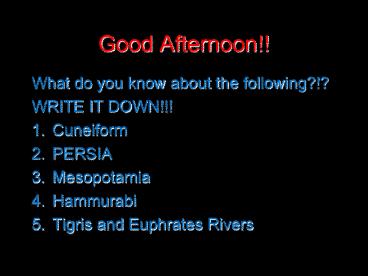Good Afternoon!! - PowerPoint PPT Presentation
1 / 36
Title: Good Afternoon!!
1
Good Afternoon!!
- What do you know about the following?!?
- WRITE IT DOWN!!!
- Cuneiform
- PERSIA
- Mesopotamia
- Hammurabi
- Tigris and Euphrates Rivers
2
Ancient Egypt
3
Fertile Nile River
4
(No Transcript)
5
Impact of Climate
- arid climate
- hot sun
- large deserts
- dry climate
oil skin
make up for sun protection and black paint to
cut glare
obstacles to invaders
must irrigate crops
6
Political Organization
- pharaoh
- pharaohs had absolute power and owned all land
however, they were expected to behave morally and
were judged on good deeds. - theocracy
- pharaoh stood at center of religion, government,
and army
god-king
government run by religious leaders
7
Economic System
- traded agricultural surplus wheat barley (from
Nile which provided silt) - mining of large mineral deposits of copper which
used for bronze tools. Gold and copper were mined
by slaves which greatly enriched the royal
treasury. - had enough economic strength to support massive
public works
Construction projects financed by the government
for the benefit and use of its citizens
8
Religion
- polytheistic
- Akhenaton forces Egyptians to worship one god
(monotheism) temporarily - king believed to rule even after death
therefore, tomb more important than earthly palace
belief in many gods
9
Preparations for the Underworld
ANUBIS weighs the dead persons heart against a
feather.
Priests protected your KA, or soul-spirit
10
Materials used in Mummification
all classes planned for their burials
1. Linen
6. Natron2. Sawdust
7. Onion3. Lichen
8. Nile Mud4. Beeswax
9. Linen Pads5. Resin
10. Frankinsense
11
Preparation for Afterlife
12
Egyptian Mummies
Ramses II1279-1212 B. C. E.
Seti I1291-1278 B. C. E.
Queen Tiye, wife of Amenhotep II1210-1200 B. C.
E.
13
Journey to the Underworld
The dead travel on the Solar Bark.
A boat for the journey is provided for a dead
pharaoh in his tomb.
14
Egyptian Book of the Dead
15
The Final Judgement
Anubis
Horus Osiris
16
Egyptian Social Hierarchy
slaves
17
Some Famous Egyptian Pharaohs
Tutankhamon1336-1327 B. C. E.
Thutmose III1504-1450 B. C. E.
Ramses II1279-1212 B. C. E.
18
Egyptian Priestly Class
19
Egyptian Scribe
20
Inventions / Innovations
- hieroglyphics
- originally pictographs, but eventually pictures
represented words as well as sounds - calendar developed (365 days and 12 months)
- hieroglyphics written on papyrus
- Math
- system of written numbers
- Science
- Set broken bones
- Surgery
- checked pulse
for economic, royal, and administrative info.
a paper-like writing material created from the
papyrus plant that grows on the banks of the Nile.
21
Hieroglyphics Alphabet
24 letters 700 phonetic symbols
22
Papyrus gt paper
Hieratic Scroll Piece
Papyrus Plant
23
Egyptian Math Draftsmenship
1 10 100 1000 10,000 100,000 1,000,000
What number is this?
24
Architecture
- Pyramids tombs for pharaoh's afterlife
- built by peasants when Nile was flooded (not
slaves)
25
Stepped Pyramid at Saqqara
26
Bent Pyramid of King Sneferu
27
Giza Pyramid Complex
28
Plan of the Great Pyramid of Khufu
29
Ancient Egyptian Housing
Middle Class Homes
Peasant Homes
30
Scenes of Ancient EgyptianDaily Life
31
Making Ancient Egyptian Wine
32
An Egyptian Womans Must-Haves
Mirror
Perfume
Whigs
33
Champollion the Rosetta Stone
34
Archaeologist, Howard Carter (1922)
35
King Tutankhamuns Tomb
36
Treasures From Tuts Tomb































![⚡[PDF]✔ The Official Downton Abbey Afternoon Tea Cookbook: Teatime Drinks, Scones, PowerPoint PPT Presentation](https://s3.amazonaws.com/images.powershow.com/10079388.th0.jpg?_=20240716091)